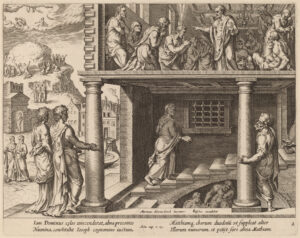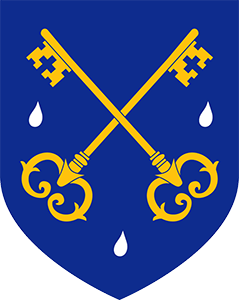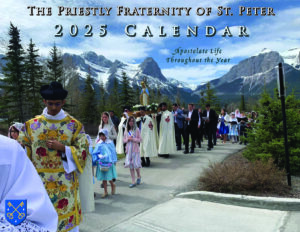The Twelve
by Fr. William Rock, FSSP

During the days between Our Lord’s Ascension and the coming of the Holy Ghost on Pentecost, St. Peter, as the head of the Church, oversaw the election of St. Matthias to replace Judas. This event is recorded in the Acts of the Apostles (1:15-16, 20-26):
In those days Peter rising up in the midst of the brethren, said (now the number of persons together was about an hundred and twenty): Men, brethren, the scripture must needs be fulfilled, which the Holy Ghost spoke before by the mouth of David concerning Judas, who was the leader of them that apprehended Jesus…For it is written in the book of Psalms: Let their habitation become desolate, and let there be none to dwell therein. And his bishopric let another take. Wherefore of these men who have companied with us, all the time that the Lord Jesus came in and went out among us, beginning from the baptism of John, until the day wherein He was taken up from us, one of these must be made a witness with us of His resurrection. And they appointed two, Joseph, called Barsabas, who was surnamed Justus, and Matthias. And praying, they said: Thou, Lord, Who knowest the heart of all men, shew whether of these two Thou hast chosen, to take the place of this ministry and apostleship, from which Judas hath by transgression fallen, that he might go to his own place. And they gave them lot, and the lot fell upon Matthias, and he was numbered with the eleven apostles.
After reading this account, the question can be raised, why was it that the Apostles needed to be restored to 12? There are several answers which can be given.
The most immediate answer is because the Apostles were to be the foundation of the New Israel just as the 12 sons of Jacob were the foundation of the Old Israel. The Sons of Jacob, the 12 Patriarchs, were the fathers of all the Israelites, and the Apostles were to be the spiritual fathers of all Christians. Therefore, it was fitting that the number of Apostles be 12 when the Church, the New Israel, manifested herself to the world.
There being 12 Apostles also shows a conformity between the Old Law and the New Law.1 Some early heretics tried to set the Old Law against the New, even saying the God of the Old Testament and the God of the New Testament were two different Gods. But having the foundation of both Testaments be 12 – 12 Sons of Jacob and 12 Apostles – shows their conformity.
In considering these two reasons, it is important to keep in mind that the 12 Patriarchs were a type, a foreshadowing, of the Apostles. God had in mind the 12 Apostles when He established the 12 Patriarchs, not that He made there be 12 Apostles because there were, by chance, 12 Patriarchs.

But why did God choose that there should be 12, not more nor fewer?
In the first place, it should be understood that 12 is considered a complete count. We are accustomed to counting on our fingers and thumbs to 10 with each digit being used for one count. Once 10 is reached, all digits have been used, and thus 10 is considered a complete count. In other cultures, such as the Babylonians, the thumb on one hand was used to count the portions of the fingers on the same hand while the digits on the other hand were used to keep track of how many times all of the portions were counted. Each finger had three portions: hand to first knuckle, first knuckle to second knuckle, and second knuckle to end. One pass through all of the portions gave a count of 12, thus making 12, and then 60 (=12*5), a complete count.2
Another explanation is that the Apostles were sent to preach the Three Persons of the Holy Trinity, represented by the number 3, to the four corners of the world, which can thus be represented by the number 4. 12, then, as it is the product of 3 and 4, represents the preaching of the Holy Trinity to the whole world. This fulfills the Lord’s Command heard in the Gospel of the Ascension: “Go ye into the whole world and preach the gospel to every creature” (Mark 16:15). That this was fulfilled is expressed by St. Paul in his letter to the Romans (10:18), where he quotes from the Book of Psalms. A fuller quotation from the Psalm reads thus: “there are no speeches nor languages, where their voices are not heard. Their sound hath gone forth into all the earth: and their words unto the ends of the world” (18:4-5).

12 also signifies a high perfection because it is 6 doubled. 6 is, according to St. Thomas Aquinas,3 a perfect number as it is the sum of its parts. What parts? Its Triangular parts. 6 is the third of what are called by modern mathematicians “Triangular Numbers,” which were previously encountered in an article on the Holy Rosary. These numbers can be visualized by using beads laid out to form a growing triangle. The number of beads which form a complete row of the growing triangle, thus forming a complete triangle, and which number is also equal to the sum of the count of rows (their “Triangular parts”), are Triangular Numbers (see accompanying image). These Triangular Numbers have a certain perfection, according to St. Thomas, exactly because they can be produced by summing their parts, that is, by summing the count of rows of their bead triangles.
Returning to the number 6, it can be seen that it is a Triangular Number as 6 beads can be used to form a full triangle. Its Triangular parts are found from the count of the number of rows of beads in a six-bead triangle. As a six-bead triangle has three rows, 1, 2, and 3 are found to be the Triangular parts of 6 with 6 itself being the sum of these parts (6=1+2+3). As this is the case, 6 is, according to St. Thomas, a perfect number. 6 is also formed by the product of its Triangular parts, 1*2*3=6. 6, then, is perfect in two ways as it can be reached by the addition and the product of its Triangular parts. Since 12 is twice 6 (6*2=12), 12 is double perfection of the perfection of 6. Now, the foundation of Christ’s Church must have a certain perfection, for, as it says in the Book of Deuteronomy (32:4), “the works of God are perfect.” Therefore, it is fitting that the number of the Apostles expresses this perfection as they are the foundation of the Church, for, as St. Paul wrote to the Ephesians (Eph2:20), the Church is “built upon the foundation of the apostles and prophets, Jesus Christ himself being the chief corner stone.”
It was fitting, then, that the number of the Apostles be returned to 12 before the public manifestation of the Church on Pentecost in order to show that they were the foundation of the New Israel and that the New Law is in continuity with the Old Law by the Apostles fulfilling their type of the 12 Patriarchs, the Sons of Jacob, to express that the Apostles were a full count, that they were tasked with the preaching of the Holy Trinity to the whole world, and to communicate the high perfection of the Church. May these thoughts accompany us during these days between the feast of the Ascension and Pentecost and help to make them fruitful.
Fr. William Rock, FSSP was ordained in the fall of 2019 and is currently assigned to St. Stanislaus Parish in Nashua, NH.
In support of the causes of Blessed Maria Cristina, Queen, and Servant of God Francesco II, King
- St. Thomas’ Commentary on Matthew, 10.1 (810).
- How 10 Fingers Became 12 Hours | EarthDate.
- St. Thomas’ Commentary on Matthew, 10.1 (810).
June 3, 2025









